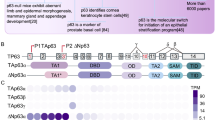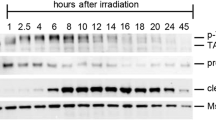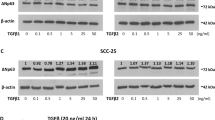Abstract
Since the discovery of the TP63 gene in 1998, many studies have demonstrated that ΔNp63, a p63 isoform of the p53 gene family, is involved in multiple functions during skin development and in adult stem/progenitor cell regulation. In contrast, TAp63 studies have been mostly restricted to its apoptotic function and more recently as the guardian of oocyte integrity. TAp63 endogenous expression is barely detectable in embryos and adult (except in oocytes), presumably because of its rapid degradation and the lack of antibodies able to detect weak expression. Nevertheless, two recent independent studies have demonstrated novel functions for TAp63 that could have potential implications to human pathologies. The first discovery is related to the protective role of TAp63 on premature aging. TAp63 controls skin homeostasis by maintaining dermal and epidermal progenitor/stem cell pool and protecting them from senescence, DNA damage and genomic instability. The second study is related to the role of TAp63, expressed by the primitive endoderm, on heart development. This unexpected role for TAp63 has been discovered by manipulation of embryonic stem cells in vitro and confirmed by the severe cardiomyopathy observed in brdm2 p63-null embryonic hearts. Interestingly, in both cases, TAp63 acts in a cell-nonautonomous manner on adjacent cells. Here, we discuss these findings and their potential connection during development.
Similar content being viewed by others
Log in or create a free account to read this content
Gain free access to this article, as well as selected content from this journal and more on nature.com
or
Abbreviations
- SKPs:
-
skin-derived precursors
- TAp63:
-
p63 containing the transactivation domain
- ΔNp63:
-
amino-deleted p63 isoform
- ES cells:
-
embryonic stem cells
- Ebs:
-
embryoid bodies
- T Bry:
-
T-box transcription factor brachyury
- Mesp1:
-
mesoderm posterior1
- Isel1:
-
Islet-1
- Chip:
-
chromatin immunoprecipitation
- TF:
-
transcription factor
- ED:
-
ectodermal dysplasia syndromes
References
Aylon Y, Oren M . New plays in the p53 theater. Curr Opin Genet Dev 2011; 21: 86–92.
Mangiulli M, Valletti A, Caratozzolo MF, Tullo A, Sbisa E, Pesole G et al. Identification and functional characterization of two new transcriptional variants of the human p63 gene. Nucleic Acids Res 2009; 37: 6092–6104.
Yang A, Kaghad M, Wang Y, Gillett E, Fleming MD, Dotsch V et al. p63, a p53 homolog at 3q27-29, encodes multiple products with transactivating, death-inducing, and dominant-negative activities. Mol Cell 1998; 2: 305–316.
Melino G . p63 is a suppressor of tumorigenesis and metastasis interacting with mutant p53. Cell Death Differ 2011; 18: 1487–1499.
Jacobs WB, Govoni G, Ho D, Atwal JK, Barnabe-Heider F, Keyes WM et al. p63 is an essential proapoptotic protein during neural development. Neuron 2005; 48: 743–756.
Khoury MP, Bourdon JC . p53 Isoforms: An Intracellular Microprocessor? Genes Cancer 2011; 2: 453–465.
Gressner O, Schilling T, Lorenz K, Schulze Schleithoff E, Koch A, Schulze-Bergkamen H et al. TAp63alpha induces apoptosis by activating signaling via death receptors and mitochondria. EMBO J 2005; 24: 2458–2471.
Liefer KM, Koster MI, Wang XJ, Yang A, McKeon F, Roop DR . Down-regulation of p63 is required for epidermal UV-B-induced apoptosis. Cancer Res 2000; 60: 4016–4020.
Suh EK, Yang A, Kettenbach A, Bamberger C, Michaelis AH, Zhu Z et al. p63 protects the female germ line during meiotic arrest. Nature 2006; 444: 624–628.
Bamberger C, Hafner A, Schmale H, Werner S . Expression of different p63 variants in healing skin wounds suggests a role of p63 in reepithelialization and muscle repair. Wound Repair Regen 2005; 13: 41–50.
Candi E, Rufini A, Terrinoni A, Dinsdale D, Ranalli M, Paradisi A et al. Differential roles of p63 isoforms in epidermal development: selective genetic complementation in p63 null mice. Cell Death Differ 2006; 13: 1037–1047.
Carroll DK, Carroll JS, Leong CO, Cheng F, Brown M, Mills AA et al. p63 regulates an adhesion programme and cell survival in epithelial cells. Nat Cell Biol 2006; 8: 551–561.
Senoo M, Pinto F, Crum CP, McKeon F . p63 is essential for the proliferative potential of stem cells in stratified epithelia. Cell 2007; 129: 523–536.
Truong AB, Kretz M, Ridky TW, Kimmel R, Khavari PA . p63 regulates proliferation and differentiation of developmentally mature keratinocytes. Genes Dev 2006; 20: 3185–3197.
Lechler T, Fuchs E . Asymmetric cell divisions promote stratification and differentiation of mammalian skin. Nature 2005; 437: 275–280.
Barton CE, Johnson KN, Mays DM, Boehnke K, Shyr Y, Boukamp P et al. Novel p63 target genes involved in paracrine signaling and keratinocyte differentiation. Cell Death Differ 2010; 1: e74.
Kouwenhoven EN, van Heeringen SJ, Tena JJ, Oti M, Dutilh BE, Alonso ME et al. Genome-wide profiling of p63 DNA-binding sites identifies an element that regulates gene expression during limb development in the 7q21 SHFM1 locus. PLoS Genet 2010; 6: e1001065.
Yang A, Zhu Z, Kettenbach A, Kapranov P, McKeon F, Gingeras TR et al. Genome-wide mapping indicates that p73 and p63 co-occupy target sites and have similar DNA-binding profiles in vivo. PLoS One 2010; 5: e11572.
Lena AM, Shalom-Feuerstein R, Rivetti di Val Cervo P, Aberdam D, Knight RA, Melino G et al. miR-203 represses ‘stemness’ by repressing DeltaNp63. Cell Death Differ 2008; 15: 1187–1195.
Antonini D, Russo MT, De Rosa L, Gorrese M, Del Vecchio L, Missero C . Transcriptional repression of miR-34 family contributes to p63-mediated cell cycle progression in epidermal cells. J Invest Dermatol 2010; 130: 1249–1257.
Su X, Chakravarti D, Cho MS, Liu L, Gi YJ, Lin YL et al. TAp63 suppresses metastasis through coordinate regulation of Dicer and miRNAs. Nature 2010; 467: 986–990.
Stransky N, Egloff AM, Tward AD, Kostic AD, Cibulskis K, Sivachenko A et al. The mutational landscape of head and neck squamous cell carcinoma. Science 2011; 333: 1157–1160.
Guo X, Keyes WM, Papazoglu C, Zuber J, Li W, Lowe SW et al. TAp63 induces senescence and suppresses tumorigenesis in vivo. Nat Cell Biol 2009; 11: 1451–1457.
Laurikkala J, Mikkola ML, James M, Tummers M, Mills AA, Thesleff I . p63 regulates multiple signalling pathways required for ectodermal organogenesis and differentiation. Development 2006; 133: 1553–1563.
Mills AA, Zheng B, Wang XJ, Vogel H, Roop DR, Bradley A . p63 is a p53 homologue required for limb and epidermal morphogenesis. Nature 1999; 398: 708–713.
Yang A, Schweitzer R, Sun D, Kaghad M, Walker N, Bronson RT et al. p63 is essential for regenerative proliferation in limb, craniofacial and epithelial development. Nature 1999; 398: 714–718.
Koster MI, Kim S, Mills AA, DeMayo FJ, Roop DR . p63 is the molecular switch for initiation of an epithelial stratification program. Genes Dev 2004; 18: 126–131.
Medawar A, Virolle T, Rostagno P, de la Forest-Divonne S, Gambaro K, Rouleau M et al. DeltaNp63 is essential for epidermal commitment of embryonic stem cells. PLoS One 2008; 3: e3441.
Shalom-Feuerstein R, Lena AM, Zhou H, De La Forest Divonne S, Van Bokhoven H, Candi E et al. DeltaNp63 is an ectodermal gatekeeper of epidermal morphogenesis. Cell Death Differ 2011; 18: 887–896.
Barton CE, Tahinci E, Barbieri CE, Johnson KN, Hanson AJ, Jernigan KK et al. DeltaNp63 antagonizes p53 to regulate mesoderm induction in Xenopus laevis. Dev Biol 2009; 329: 130–139.
van Bokhoven H, McKeon F . Mutations in the p53 homolog p63: allele-specific developmental syndromes in humans. Trends Mol Med 2002; 8: 133–139.
Crum CP, McKeon FD . p63 in epithelial survival, germ cell surveillance, and neoplasia. Annu Rev Pathol 2010; 5: 349–371.
Koster MI . p63 in skin development and ectodermal dysplasias. J Invest Dermatol 2010; 130: 2352–2358.
Vanbokhoven H, Melino G, Candi E, Declercq W . p63, a story of mice and men. J Invest Dermatol 2011; 131: 1196–1207.
Su X, Paris M, Gi YJ, Tsai KY, Cho MS, Lin YL et al. TAp63 prevents premature aging by promoting adult stem cell maintenance. Cell Stem Cell 2009; 5: 64–75.
Rouleau M, Medawar A, Hamon L, Shivtiel S, Wolchinsky Z, Zhou H et al. TAp63 is important for cardiac differentiation of embryonic stem cells and heart development. Stem Cells 2011; 29: 1672–1683.
Keyes WM, Wu Y, Vogel H, Guo X, Lowe SW, Mills AA . p63 deficiency activates a program of cellular senescence and leads to accelerated aging. Genes Dev 2005; 19: 1986–1999.
Fernandes KJ, McKenzie IA, Mill P, Smith KM, Akhavan M, Barnabe-Heider F et al. A dermal niche for multipotent adult skin-derived precursor cells. Nat Cell Biol 2004; 6: 1082–1093.
Toma JG, Akhavan M, Fernandes KJ, Barnabe-Heider F, Sadikot A, Kaplan DR et al. Isolation of multipotent adult stem cells from the dermis of mammalian skin. Nat Cell Biol 2001; 3: 778–784.
Biernaskie J, Paris M, Morozova O, Fagan BM, Marra M, Pevny L et al. SKPs derive from hair follicle precursors and exhibit properties of adult dermal stem cells. Cell Stem Cell 2009; 5: 610–623.
Jinno H, Morozova O, Jones KL, Biernaskie JA, Paris M, Hosokawa R et al. Convergent genesis of an adult neural crest-like dermal stem cell from distinct developmental origins. Stem Cells 2010; 28: 2027–2040.
Beretta C, Chiarelli A, Testoni B, Mantovani R, Guerrini L . Regulation of the cyclin-dependent kinase inhibitor p57Kip2 expression by p63. Cell Cycle 2005; 4: 1625–1631.
Beaudry VG, Attardi LD . SKP-ing TAp63: stem cell depletion, senescence, and premature aging. Cell Stem Cell 2009; 5: 1–2.
Hu YF, Zhang ZJ, Sieber-Blum M . An epidermal neural crest stem cell (EPI-NCSC) molecular signature. Stem Cells 2006; 24: 2692–2702.
Amoh Y, Li L, Campillo R, Kawahara K, Katsuoka K, Penman S et al. Implanted hair follicle stem cells form Schwann cells that support repair of severed peripheral nerves. Proc Natl Acad Sci USA 2005; 102: 17734–17738.
Biernaskie J . Human hair follicles: ″bulging″ with neural crest-like stem cells. J Invest Dermatol 2010; 130: 1202–1204.
Sharpless NE, DePinho RA . How stem cells age and why this makes us grow old. Nat Rev Mol Cell Biol 2007; 8: 703–713.
Gu X, Lundqvist EN, Coates PJ, Thurfjell N, Wettersand E, Nylander K . Dysregulation of TAp63 mRNA and protein levels in psoriasis. J Invest Dermatol 2006; 126: 137–141.
McGrath JA, Duijf PH, Doetsch V, Irvine AD, de Waal R, Vanmolkot KR et al. Hay-Wells syndrome is caused by heterozygous missense mutations in the SAM domain of p63. Hum Mol Genet 2001; 10: 221–229.
Jones DL, Rando TA . Emerging models and paradigms for stem cell ageing. Nat Cell Biol 2011; 13: 506–512.
Liu L, Rando TA . Manifestations and mechanisms of stem cell aging. J Cell Biol 2011; 193: 257–266.
Lu C, Lu S, Liang W, Li J, Dou X, Bian C et al. TAp63alpha Mediates Chemotherapeutic Agent-Induced Apoptosis in Human Bone Marrow Mesenchymal Stem Cells. Stem Cells Dev 2011; 20: 1319–1326.
Gago N, Perez-Lopez V, Sanz-Jaka JP, Cormenzana P, Eizaguirre I, Bernad A et al. Age-dependent depletion of human skin-derived progenitor cells. Stem Cells 2009; 27: 1164–1172.
Bahta AW, Farjo N, Farjo B, Philpott MP . Premature senescence of balding dermal papilla cells in vitro is associated with p16(INK4a) expression. J Invest Dermatol 2008; 128: 1088–1094.
Liu Y, Asakura M, Inoue H, Nakamura T, Sano M, Niu Z et al. Sox17 is essential for the specification of cardiac mesoderm in embryonic stem cells. Proc Natl Acad Sci USA 2007; 104: 3859–3864.
Cai CL, Liang X, Shi Y, Chu PH, Pfaff SL, Chen J et al. Isl1 identifies a cardiac progenitor population that proliferates prior to differentiation and contributes a majority of cells to the heart. Dev Cell 2003; 5: 877–889.
Greulich F, Rudat C, Kispert A . Mechanisms of T-box gene function in the developing heart. Cardiovasc Res 2011; 91: 212–222.
Pozzi S, Zambelli F, Merico D, Pavesi G, Robert A, Maltere P et al. Transcriptional network of p63 in human keratinocytes. PLoS One 2009; 4: e5008.
Antonini D, Rossi B, Han R, Minichiello A, Di Palma T, Corrado M et al. An autoregulatory loop directs the tissue-specific expression of p63 through a long-range evolutionarily conserved enhancer. Mol Cell Biol 2006; 26: 3308–3318.
Rochais F, Dandonneau M, Mesbah K, Jarry T, Mattei MG, Kelly RG . Hes1 is expressed in the second heart field and is required for outflow tract development. PLoS One 2009; 4: e6267.
Liao J, Aggarwal VS, Nowotschin S, Bondarev A, Lipner S, Morrow BE . Identification of downstream genetic pathways of Tbx1 in the second heart field. Dev Biol 2008; 316: 524–537.
Valenzise M, Arrigo T, De Luca F, Privitera A, Frigiola A, Carando A et al. R298Q mutation of p63 gene in autosomal dominant ectodermal dysplasia associated with arrhythmogenic right ventricular cardiomyopathy. Eur J Med Genet 2008; 51: 497–500.
Rinne T, Clements SE, Lamme E, Duijf PH, Bolat E, Meijer R et al. A novel translation re-initiation mechanism for the p63 gene revealed by amino-terminal truncating mutations in Rapp-Hodgkin/Hay-Wells-like syndromes. Hum Mol Genet 2008; 17: 1968–1977.
Chiodini BD, Lewis CM . Meta-analysis of 4 coronary heart disease genome-wide linkage studies confirms a susceptibility locus on chromosome 3q. Arterioscler Thromb Vasc Biol 2003; 23: 1863–1868.
Chitayat D, Babul R, Silver MM, Jay V, Teshima IE, Babyn P et al. Terminal deletion of the long arm of chromosome 3 [46,XX,del(3)(q27-->qter)]. Am J Med Genet 1996; 61: 45–48.
Senzaki H, Inui M, Ban S, Masutani S, Morsy M, Kobayashi T et al. Dilated cardiomyopathy in a 3-year-old girl with a terminal deletion, 46,XX,del(3)(q27-qter), of the long arm of chromosome 3. Eur J Pediatr 2003; 162: 403–405.
Fujitani M, Cancino GI, Dugani CB, Weaver IC, Gauthier-Fisher A, Paquin A et al. TAp73 acts via the bHLH Hey2 to promote long-term maintenance of neural precursors. Curr Biol 2010; 20: 2058–2065.
Tomita Y, Matsumura K, Wakamatsu Y, Matsuzaki Y, Shibuya I, Kawaguchi H et al. Cardiac neural crest cells contribute to the dormant multipotent stem cell in the mammalian heart. J Cell Biol 2005; 170: 1135–1146.
Rochais F, Mesbah K, Kelly RG . Signaling pathways controlling second heart field development. Circ Res 2009; 104: 933–942.
Steinbach SK, El-Mounayri O, Dacosta RS, Frontini MJ, Nong Z, Maeda A et al. Directed differentiation of skin-derived precursors into functional vascular smooth muscle cells. Arterioscler Thromb Vasc Biol 2011; 31: 2938–2948.
Acknowledgements
We thank David Kaplan, Ruby Shalom-Feuerstein and Wim Declercq for their comments, suggestions and criticisms. Part of this work was supported for DA by the Sixth EEC Framework Program within the EPISTEM project (LSHB-CT-2005-019067), the Agence Nationale pour la Recherche (ANR BLANC 06 and GENOPAT 08) and the Israel Science Foundation.
Author information
Authors and Affiliations
Corresponding author
Ethics declarations
Competing interests
The authors declare no conflict of interest.
Additional information
Edited by G Melino
Rights and permissions
About this article
Cite this article
Paris, M., Rouleau, M., Pucéat, M. et al. Regulation of skin aging and heart development by TAp63. Cell Death Differ 19, 186–193 (2012). https://doi.org/10.1038/cdd.2011.181
Received:
Revised:
Accepted:
Published:
Issue date:
DOI: https://doi.org/10.1038/cdd.2011.181
Keywords
This article is cited by
-
MiR34 inhibition induces human heart progenitor proliferation
Cell Death & Disease (2018)
-
ΔNp63 targets cytoglobin to inhibit oxidative stress-induced apoptosis in keratinocytes and lung cancer
Oncogene (2016)
-
How Does p73 Cause Neuronal Defects?
Molecular Neurobiology (2016)
-
The function of Drosophila p53 isoforms in apoptosis
Cell Death & Differentiation (2015)
-
Role of the p63-FoxN1 regulatory axis in thymic epithelial cell homeostasis during aging
Cell Death & Disease (2013)



